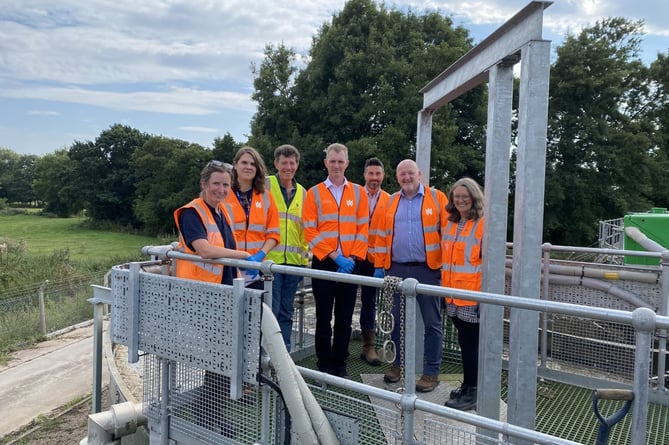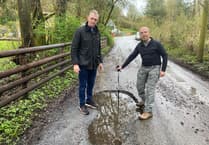Dŵr Cymru Welsh Water has welcomed local politicians to its Raglan sewage treatment works to learn how phosphorus is removed from wastewater.
David Davies MP and Peter Fox MS visited the plant on Chepstow Road to better understand the process of sewage treatment and phosphate stripping.
They were joined by Mike Dunsbee from Friends of the Lower Wye.
The visit on Friday (2 September) formed part of a continued dialogue with both Welsh Water and Natural Resources Wales (NRW) to discuss ongoing action aimed at improving the cleanliness of the Usk and Wye rivers.
Raglan is one of around 55 sewage treatment works in Wales where phosphorous is removed. However, phosphate stripping is set to be widely rolled out to other plants.
Monmouth MP Mr Davies said: “The health of our rivers remains a top priority and I am pleased to say things are moving in the right direction with major investments aimed at reducing phosphates.
“We heard how wastewater at Raglan is dosed with ferric, which removes phosphorous. It does leave a tiny amount of iron in the final effluent before discharge, although this is strictly limited to a maximum of 4mg per litre.
“Out of 828 sewage treatment works in Wales, just over 50 have phosphate stripping and I warmly welcome plans to greatly extend this.”
The group was also shown the storm overflow, which is designed to act as a relief valve when the sewerage system is at risk of being overwhelmed during heavy rainfall.
“This is another large unit, but it cannot accommodate an infinite amount of water,” added Mr Davies.
“To prevent the sewage system from becoming overwhelmed and causing flooding, or even backing up into people’s homes, storm overflows are used to release extra rainwater and wastewater into rivers and seas.
“However, it is incorrect for people to suggest that what gets pumped into rivers during storms is raw human faeces. To be accurate, raw sewage constitutes less than one per cent of the storm waters that discharge during heavy periods of rainfall.
“That said, this is not in any way an excuse and we all agree it has to be reduced further.”
In England, the Department for Environment, Food and Rural Affairs is consulting on a plan to limit the amount of phosphorous that water companies are allowed to discharge into the river network as part of the Environment Act.
The new regulation would require sewage treatment works to remove the maximum amount of phosphorus possible using current technology within rivers that are not achieving favourable conservation status, regardless of the source of the pollution.
However, the Welsh Government has yet to confirm if it will do the same in Wales.
“This is going to be very expensive and water companies and therefore customers will be expected to pay the costs,” said Mr Davies.
“At the moment, the Welsh Government hasn’t decided whether to launch a similar consultation so I will be writing to climate change minister Julie James to find out why.”
Monmouth MS Peter Fox said: “Sewage treatment is a fundamental part of everyday life and gaining a better understanding of how our waste is processed was helpful.
“As we know, one of the major issues causing concern and havoc in our rivers are the levels of nitrates and phosphates entering water courses from either sewage, or from agriculture.
“It was reassuring to see how Welsh Water was managing to strip phosphates out of treated sewage and I look forward to seeing more systems like the one in Raglan being put in place across the Wye and Usk catchments.”
Sharon Ellwood, Welsh Water’s head of waste water assets, also attended the meeting.
“It was great to welcome David Davies MP and Peter Fox MS, along with Friends of the Lower Wye, to show them how we remove phosphates as part of the wastewater treatment process at our site in Raglan,” she said.
“Our modelling of the River Usk shows that our assets are responsible for between 21 per cent to 23 per cent of the phosphates in the river.
“There are a number of other factors which contribute to phosphate levels in watercourses and we are committed to ensuring we do all that we can to work with other stakeholders as part of the newly formed Usk Catchment Partnership, led by the Brecon Beacons National Park Authority, which aims to restore the ecological health of the river and its wider catchment.”




